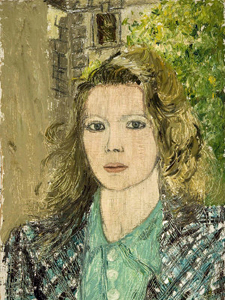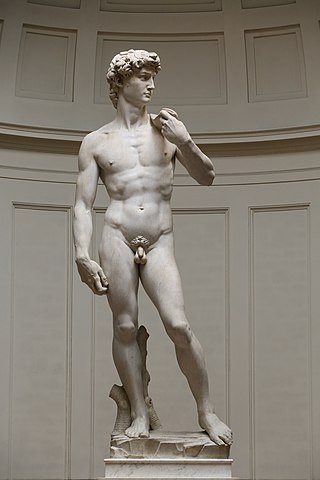Related Research Articles

Egon Leo Adolf Ludwig Schiele was an Austrian Expressionist painter. His work is noted for its intensity and its raw sexuality, and for the many self-portraits the artist produced, including nude self-portraits. The twisted body shapes and the expressive line that characterize Schiele's paintings and drawings mark the artist as an early exponent of Expressionism. Gustav Klimt, a figurative painter of the early 20th century, was a mentor to Schiele.

Erotic art is a broad field of the visual arts that includes any artistic work intended to evoke arousal. It usually depicts human nudity or sexual activity, and has included works in various visual mediums, including drawings, engravings, films, paintings, photographs, and sculptures. Some of the earliest known works of art include erotic themes, which have recurred with varying prominence in different societies throughout history. However, it has also been widely considered taboo, with either social norms or laws restricting its creation, distribution, and possession. This is particularly the case when it is deemed pornographic, immoral, or obscene.

Guerrilla Girls is an anonymous group of feminist, female artists devoted to fighting sexism and racism within the art world. The group formed in New York City in 1985, born out of a picket against the Museum of Modern Art the previous year. The core of the group's work is bringing gender and racial inequality into focus within the greater arts community and society at large. The Guerrilla Girls employ culture jamming in the form of posters, books, billboards, lectures, interviews, public appearances and internet interventions to expose disparities, discrimination, and corruption. They also often use humor in their work to make their serious messages engaging. The Guerrilla Girls are known for their "guerrilla" tactics, hence their name, such as hanging up posters or staging surprise exhibitions. To remain anonymous, members don gorilla masks. To permit individual identities in interviews, they use pseudonyms that refer to deceased female artists such as Frida Kahlo, Käthe Kollwitz, and Alice Neel, as well as writers and activists, such as Gertrude Stein and Harriet Tubman. According to GG1, identities are concealed because issues matter more than individual identities, "Mainly, we wanted the focus to be on the issues, not on our personalities or our own work."

The Thinker, by Auguste Rodin, is a bronze sculpture situated atop a stone pedestal depicting a nude male figure of heroic size sitting on a rock. He is seen leaning over, his right elbow placed on his left thigh, holding the weight of his chin on the back of his right hand. The pose is one of deep thought and contemplation, and the statue is often used as an image to represent philosophy.

Gaston Lachaise was a French-born sculptor, active in America in the early 20th century. A native of Paris, he is most noted for his robust female nudes such as his heroic Standing Woman. Gaston Lachaise was taught the fundamentals of European sculpture while living in France. While still a student, he met and fell in love with an older American woman, Isabel Dutaud Nagle, then followed her after she returned to America. There, he became profoundly impressed by the great vitality and promise of his adopted country. Those life-altering experiences clarified his artistic vision and inspired him to define the female nude in a new and powerful manner. His drawings, typically made as ends in themselves, also exemplify his remarkably new treatment of the female body.
Jacqueline Louise Livingston was an American photographer known for her work exploring woman's role as artist and person and investigating the boundaries of intimacy and propriety.

An art model poses, often nude, for visual artists as part of the creative process, providing a reference for the human body in a work of art. As an occupation, modeling requires the often strenuous 'physical work' of holding poses for the required length of time, the 'aesthetic work' of performing a variety of interesting poses, and the 'emotional work' of maintaining a socially ambiguous role. While the role of nude models is well-established as a necessary part of artistic practice, public nudity remains transgressive, and models may be vulnerable to stigmatization or exploitation. Artists may also have family and friends pose for them, in particular for works with costumed figures.
Wangechi Mutu is a Kenyan American visual artist, known primarily for her painting, sculpture, film, and performance work. Born in Kenya, Mutu now splits her time between her studio there in Nairobi and her studio in Brooklyn, New York, where she has lived and worked for over 20 years. Mutu's work has directed the female body as subject through collage painting, immersive installation, and live and video performance while exploring questions of self-image, gender constructs, cultural trauma, and environmental destruction and notions of beauty and power.

Anne Whitney was an American sculptor and poet. She made full-length and bust sculptures of prominent political and historical figures, and her works are in major museums in the United States. She received prestigious commissions for monuments. Two statues of Samuel Adams were made by Whitney and are located in Washington, D.C.'s National Statuary Hall Collection and in front of Faneuil Hall in Boston. She also created two monuments to Leif Erikson.

Sylvia Sleigh was a Welsh-born naturalised American realist painter who lived and worked in New York City. She is known for her role in the feminist art movement and especially for reversing traditional gender roles in her paintings of nude men, often using conventional female poses from historical paintings by male artists like Diego Vélazquez, Titian, and Jean-Auguste-Dominique Ingres. Her most well-known subjects were art critics, feminist artists, and her husband, Lawrence Alloway.

Feminist art is a category of art associated with the feminist movement of the late 1960s and 1970s. Feminist art highlights the societal and political differences women experience in their lives. The goal of this art form is to bring a positive and understanding change to the world, leading to equality or liberation. Media used range from traditional art forms, such as painting, to more unorthodox methods such as performance art, conceptual art, body art, craftivism, video, film, and fiber art. Feminist art has served as an innovative driving force toward expanding the definition of art by incorporating new media and a new perspective.

The nude, as a form of visual art that focuses on the unclothed human figure, is an enduring tradition in Western art. It was a preoccupation of Ancient Greek art, and after a semi-dormant period in the Middle Ages returned to a central position with the Renaissance. Unclothed figures often also play a part in other types of art, such as history painting, including allegorical and religious art, portraiture, or the decorative arts. From prehistory to the earliest civilizations, nude female figures were generally understood to be symbols of fertility or well-being.

The Swimming Hole is an 1884–85 painting by the American artist Thomas Eakins (1844–1916), Goodrich catalog #190, in the collection of the Amon Carter Museum of American Art in Fort Worth, Texas. Executed in oil on canvas, it depicts six men swimming naked in a lake, and is considered a masterpiece of American painting. According to art historian Doreen Bolger it is "perhaps Eakins' most accomplished rendition of the nude figure", and has been called "the most finely designed of all his outdoor pictures". Since the Renaissance, the human body has been considered both the basis of artists' training and the most challenging subject to depict in art, and the nude was the centerpiece of Eakins' teaching program at the Pennsylvania Academy of the Fine Arts. For Eakins, this picture was an opportunity to display his mastery of the human form.
Julie Rrap is an Australian contemporary artist who was raised on the Gold Coast in Queensland. She was born Julie Parr, and reversed her name to express her sense of opposition. Since the mid-1970's she has worked in photography, painting, sculpture, video and performance. Julie's work expresses her interest in images of the body, especially the female body.

Nymph and Fawn is a public artwork by American artist Isidore Konti and located within the Oldfields–Lilly House & Gardens estate on the grounds of the Indianapolis Museum of Art (IMA), near Indianapolis, Indiana. Created in 1917, the bronze sculpture is also a working fountain. It portrays a female nude pouring water from an urn while standing beside a small fawn.
Carroll Dunham is an American painter. Working since the late 1970s, Dunham's career reached critical renown in the 1980s when he first exhibited with Baskerville + Watson, a decade during which many artists returned to painting. He is known for his conceptual approach to painting and drawing and his interest in exploring the relationship between abstraction and figuration.
Amy Jenkins is an American artist from Peterborough, New Hampshire who is recognized for her work in video installation and experimental film.
Sally Smart is an Australian contemporary artist known for her large-scale assemblage installations that incorporate a range of media, including felt cut-outs, painted canvas, drawings, screen-printing, printed fabric and photography, performance and video. Her art addresses gender and identity politics and questions the relationships between body and culture, including trans-national ideas that shaped cultural history. She has exhibited widely throughout Australia and internationally, and her works are held in major galleries in Australia and around the world.
Stephen J. Kaltenbach is an American artist and author based in Sacramento, California.
Salvatore Grippi (1921-2017) was an American artist and founder of the art department at Ithaca College.
References
- 1 2 3 4 5 6 "Don Doe, Artist's Statement". MoMa PS 1 website. Retrieved February 25, 2015.
- 1 2 3 "Pierogi Flatfiles Collection". Pierogi website. Retrieved February 25, 2015.
- 1 2 "The MOMA Collection". MoMa Collection Website. Retrieved February 25, 2015.
- ↑ "Art Institute of Chicago Collections". Art Institute of Chicago. Retrieved February 25, 2015.
- ↑ "Cornell University Collections". Cornell University. Retrieved February 25, 2015.
- ↑ ks. "Art by Don Doe from the PIEROGI Online Flat Files". flatfiles.pierogi2000.com. Retrieved 2016-01-22.
- ↑ "Pierogi Interview of Donald Doe". Pierogi website. 27 May 2014. Retrieved October 29, 2014.
- ↑ Johnson, Ken (14 March 2003). "Art in Review; Don Doe". The New York Times. Retrieved March 14, 2003.
- ↑ "Deutsche Bank Art Magazines". Deutsche Bank website. Retrieved October 29, 2014.
- 1 2 3 "Artist Page; Don Doe". Morgan Lehman Gallery. Retrieved October 29, 2014.
- ↑ "Artist Page; Don Doe". Re-Title, International Contemporary Art. Archived from the original on September 17, 2015. Retrieved August 12, 2015.
{{cite web}}: CS1 maint: unfit URL (link) - 1 2 "Dangerous Waters". Herbert F. Johnson Museum of Art, Cornell University.
- ↑ "Bodies Unbound, the Classical and Grotesque". History of Art Majors' Society, Cornell University.
- ↑ "Donald Doe, Morgan Lehman Gallery Website". Morgan Lehman Gallery Website. Retrieved February 25, 2015.